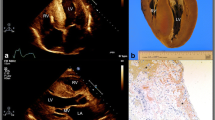Optional statement
Amyloidosis is a systemic disease in which clinical manifestations are caused by the replacement of normal tissue with insoluble amyloid fibrils. Cardiac involvement causes a restrictive cardiomyopathy and is associated with poor functional outcomes. Cardiac magnetic resonance imaging and measurement of B-type natriuretic peptide are particularly helpful in distinguishing restrictive cardiomyopathy from constrictive pericarditis, but a tissue biopsy is required to make the diagnosis of amyloidosis. Although standard treatment options for congestive heart failure may provide symptomatic relief in cardiac amyloidosis, prognosis remains dismal. Judicious diuretic use remains the mainstay of therapy, but achieving optimal fluid balance is difficult because patients are usually “preload dependent.” Angiotensin-converting enzyme inhibitors in low doses are often helpful but may lead to orthostatic hypotension, particularly in patients who also have involvement of the autonomic nervous system. β Blockers may be useful if given relatively early in the disease process, but should be used with caution in patients with advanced disease because they may exacerbate symptoms. Therapy aimed at the underlying disease process in primary systemic amyloidosis is based on treatment regimens used in multiple myeloma, such as melphalan and prednisone. These offer limited benefit when cardiac involvement is significant, but newer treatments, including the novel anthracycline 4′-iodo-4′-deoxydoxorubicin, potentially combined with autologous stem cell transplantation, offer some hope for the future.
Similar content being viewed by others
References and Recommended Reading
Kyle R: Amyloidosis. Circulation 1995, 91:1269–1270.
Grogan M, Gertz MA, Kyle R, et al.: Five or more years of survival in patients with primary systemic amyloidosis and biopsy-proven cardiac involvement. Am J Cardiol 2000, 85:664–665.
Merlini G, Bellotti V: Molecular mechanisms of amyloidosis. N Engl J Med 2003, 349:583–596.
Jacobson D, Pastore R, Yaghoubian R, et al.: Variantsequence transthyretin (isoleucine 122) in late-onset cardiac amyloidosis in black Americans. N Engl J Med 1997, 336:466–473.
Swanton R, Brooksby I, Davies M, et al.: Systolic and diastolic ventricular function in cardiac amyloidosis: studies in six cases diagnosed with endomyocardial biopsy. Am J Cardiol 1977, 39:658–664.
Liao R, Jain M, Teller P, et al.: Infusion of light chains from patients with cardiac amyloidosis causes diastolic dysfunction in isolated mouse hearts. Circulation 2001, 104:1594–1597.
Chew C, Mokhtar G, Raphael M: The functional defect in amyloid heart disease: the “stiff heart” syndrome. Am J Cardiol 1975, 36:438–444.
Carroll J, Gaasch W, McAdam P: Amyloid cardiomyopathy: characterization by a distinctive voltage/mass relation. Am J Cardiol 1982, 49:9–13.
Palladini G, Campana C, Klersy C, et al.: Serum N-terminal pro-brain natriuretic peptide is a sensitive marker for myocardial dysfunction in AL amyloidosis. Circulation 2003, 107:2440–2445.
Rahman J, Helou E, Gelzer-Bell R, et al.: Noninvasive diagnosis of biopsy proven cardiac amyloidosis. J Am Coll Cardiol 2004, 43:410–415.
Fatorri R, Rocchi G, Cellati F, et al.: Contribution of magnetic resonance imaging in identification of amyloid cardiomyopathy. Am Heart J 1998, 136:824–830.
Kwong R, Falk R: Cardiovascular magnetic resonance in cardiac amyloidosis. Circulation 2005, 111:122–124.
Rubinow A, Skinner M, Cohen A: Digoxin sensitivity in amyloid cardiomyopathy. Circulation 1981, 63:1285–1288.
Gertz M, Skinner M, Connors L: Selective binding of nifedipine to amyloid fibrils. Am J Cardiol 1985, 55:1646.
Choufani E, Sanchorawala V, Ernst T, et al.: Acquired factor X deficiency in patients with amyloid lightchain amyloidosis: incidence, bleeding manifestations, and response to high-dose chemotherapy. Blood 2001, 97:1885–1887.
Kyle R, Gertz M, Greipp P, et al.: A trial of three regimens for primary amyloidosis: colchicine alone, melphalan and prednisone, and melphalan, prednisone, and colchicine. N Engl J Med 1997, 336:1202–1207.
Gertz M, Lacy M, Just J, et al.: Prospective randomized trial of melphalan and prednisone versus vincristine, carmustine, melphalan, cyclophosphamide, and prednisone in the treatment of primary systemic amyloidosis. J Clin Oncol 1999, 17:262–267.
Skinner M, Sanchorawala V, Seldin D, et al.: High-dose melphalan and autologous stem-cell transplantation in patients with AL amyloidosis: an 8-year study. Ann Intern Med 2004, 140:85–93.
Comenzo R, Vosburgh E, Falk R: Dose-intensive melphalan with blood stem-cell support for the treatment of AL (amyloid light-chain) amyloidosis: survival and responses in 25 patients. Blood 1998, 91:3662–3670.
Gianni L, Bellotti V, Gianni M, et al.: New drug therapy of amyloidosis: resorption of AL-type deposits with 4′-iodo-4′-deoxydoxorubicin. Blood 1995, 86:855–861.
Merlini G, Anesi E, Garini P, et al.: Treatment of AL amyloidosis with 4′-iodo-4′-deoxydoxorubicin: an update. Blood 1999, 93:1112–1113.
Dubrey S, Burke M, Khaghani A, et al.: Long-term results of heart transplantation in patients with amyloid heart disease. Heart 2001, 85:202–207. Reviews the results of 13 years of follow-up of patients with cardiac amyloidosis undergoing heart transplantation.
Cohen H, Lessin L, Kyle R, et al.: Resolution of primary amyloidosis during chemotherapy: studies in patients with nephrotic syndrome. Ann Intern Med 1975, 82:466–473.
Merlini G, Ascari E, Amboldi N, et al.: Interaction of the anthracycline 4′-iodo-4′-deoxydoxorubicin with amyloid fibrils: Inhibition of amyloidogenesis. Proc Natl Acad Sci U S A 1995, 92:2959–2963.
Author information
Authors and Affiliations
Rights and permissions
About this article
Cite this article
Parikh, S., Lemos, J.A.d. Current therapeutic strategies in cardiac amyloidosis. Curr Treat Options Cardio Med 7, 443–448 (2005). https://doi.org/10.1007/s11936-005-0029-8
Issue Date:
DOI: https://doi.org/10.1007/s11936-005-0029-8




